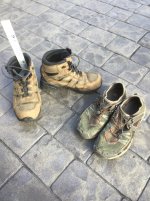I'm shopping for new boots, which I haven't done in decades. Two questions about boot height. The first is about non-winter boot use; the second is about winter boot use.
1. For those of you who wear boots when canoeing, portaging or general canoe tripping—and, since there's probably an overlap, when non-winter hiking or hunting—what height boots do you prefer? Perhaps you have more than one answer for different non-winter uses.
2. What height boot do you prefer for snow and other winter uses?
If you use the same boot or same height boot in all seasons, that experience would also be of interest.
My former boots have been 6" uninsulated Bean Boots, which I still have but don't use for canoeing or in snow. Also, 12" insulated LaCrosse rubber boots and 10" insulated Bean Boots, both of which are 41-years-old and are getting tossed. Finally, I've had 18" LaCrosse Burly rubber boots for 28 years, which are also getting tossed.
I've taken delivery of two pairs of boots so far, both on good sales, but I'm not using them outside the house yet because I'm unsure about my choices, especially the heights, and may want to return one or both. For general use I bought THESE 10" uninsulated leather Irish Setter boots, and for winter/snow I bought THESE 10" nylon/leather Sorel pac boots.
Again, I'm primarily interested in height preferences, but all boot discussion welcome.
1. For those of you who wear boots when canoeing, portaging or general canoe tripping—and, since there's probably an overlap, when non-winter hiking or hunting—what height boots do you prefer? Perhaps you have more than one answer for different non-winter uses.
2. What height boot do you prefer for snow and other winter uses?
If you use the same boot or same height boot in all seasons, that experience would also be of interest.
My former boots have been 6" uninsulated Bean Boots, which I still have but don't use for canoeing or in snow. Also, 12" insulated LaCrosse rubber boots and 10" insulated Bean Boots, both of which are 41-years-old and are getting tossed. Finally, I've had 18" LaCrosse Burly rubber boots for 28 years, which are also getting tossed.
I've taken delivery of two pairs of boots so far, both on good sales, but I'm not using them outside the house yet because I'm unsure about my choices, especially the heights, and may want to return one or both. For general use I bought THESE 10" uninsulated leather Irish Setter boots, and for winter/snow I bought THESE 10" nylon/leather Sorel pac boots.
Again, I'm primarily interested in height preferences, but all boot discussion welcome.




